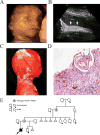Novel pathogenic variants in FOXP3 in fetuses with echogenic bowel and skin desquamation identified by ultrasound
- PMID: 28317311
- PMCID: PMC5515470
- DOI: 10.1002/ajmg.a.38144
Novel pathogenic variants in FOXP3 in fetuses with echogenic bowel and skin desquamation identified by ultrasound
Abstract
Immunodysregulation, Polyendocrinopathy, Enteropathy, X-linked (IPEX) syndrome is a rare, X-linked recessive disease that affects regulatory T cells (Tregs) resulting in diarrhea, enteropathy, eczema, and insulin-dependent diabetes mellitus. IPEX syndrome is caused by pathogenic alterations in FOXP3 located at Xp11.23. FOXP3 encodes a transcription factor that interacts with several partners, including NFAT and NF-κB, and is necessary for the proper cellular differentiation of Tregs. Although variable, the vast majority of IPEX syndrome patients have onset of disease during infancy with severe enteropathy. Only five families with prenatal presentation of IPEX syndrome have been reported. Here, we present two additional prenatal onset cases with novel inherited frameshift pathogenic variants in FOXP3 that generate premature stop codons. Ultrasound findings in the first patient identified echogenic bowel, echogenic debris, scalp edema, and hydrops. In the second patient, ultrasound findings included polyhydramnios with echogenic debris, prominent fluid-filled loops of bowel, and echogenic bowel. These cases further broaden the phenotypic spectrum of IPEX syndrome by describing previously unappreciated prenatal ultrasound findings associated with the disease.
Keywords: FOXP3; IPEX; X-linked; prenatal.
© 2017 Wiley Periodicals, Inc.
Figures


References
-
- Baris S, Schulze I, Ozen A, Aydiner EK, Altuncu E, Karasu GT, Ozturk N, Lorenz M, Schwarz K, Vraetz T, Ehl S, Barlan IB. Clinical heterogeneity of immunodysregulation, polyendocrinopathy, enteropathy, X-linked: pulmonary involvement as a non-classical disease manifestation. J. Clin. Immunol. 2014;34:601–606. - PubMed
-
- Di Nunzio S, Cecconi M, Passerini L, McMurchy AN, Baron U, Turbachova I, Vignola S, Valencic E, Tommasini A, Junker A, Cazzola G, Olek S, Levings MK, Perroni L, Roncarolo MG, Bacchetta R. Wild-type FOXP3 is selectively active in CD4+CD25(hi) regulatory T cells of healthy female carriers of different FOXP3 mutations. Blood. 2009;114:4138–4141. - PubMed
-
- Fontenot JD, Gavin MA, Rudensky AY. Foxp3 programs the development and function of CD4+CD25+ regulatory T cells. Nat. Immunol. 2003;4:330–336. - PubMed
Publication types
MeSH terms
Substances
Supplementary concepts
Grants and funding
LinkOut - more resources
Full Text Sources
Other Literature Sources
Medical

